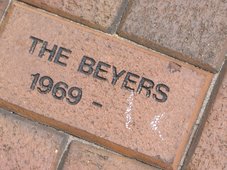Tuesday, October 6, 2009
Law Enforcement's Social Network
Talk about the power of networking.
WaPo has an interesting story today about two men accused of stealing jewelry in a string of heists during real estate open houses across suburban Maryland and Northern Virginia. Police said they finally caught up with the pair after one agent grew suspicious of the men and "alerted the Northern Virginia Association of Realtors, which put out a bulletin giving a description of the suspects and warning thousands of agents about the activity."
Two weeks later, agent Jim Bryant was holding an open house in McLean when he saw two men who fit the description pull up and quickly exit their car, he said. The men split up when they walked in the door, and Bryant said he decided to write down their vehicle's license plate number.
When they saw what Bryant was doing, they left. Bryant then e-mailed Alexandria police Detective Daniel Plank, who checked the license plate number and came up with Palmer's name.
Plank then searched a regional pawnshop database and learned that Palmer had been pawning large amounts of jewelry. Plank visited one of the pawnshops in Howard County and the owner recognized photos of Palmer and Goldstein, Plank said.
So, when an agent in Baltimore called police Sunday after seeing suspicious activity and remembering the bulletin about the thefts, officers knew to check the suspects' pockets. Then, it was easy for authorities to piece together the case, Plank said.
Easy maybe, but an example of the growing power of our interconnectedness. A regional alert from the Realtors group. A run through a license plate database. An e-mail sent from an agent in McLean to a detective in Alexandria. A check of a pawnshop database. Archived photos of the suspects. And a regional police bulletin that led police in Baltimore to know to check a suspicious person's pockets.
WaPo has an interesting story today about two men accused of stealing jewelry in a string of heists during real estate open houses across suburban Maryland and Northern Virginia. Police said they finally caught up with the pair after one agent grew suspicious of the men and "alerted the Northern Virginia Association of Realtors, which put out a bulletin giving a description of the suspects and warning thousands of agents about the activity."
Two weeks later, agent Jim Bryant was holding an open house in McLean when he saw two men who fit the description pull up and quickly exit their car, he said. The men split up when they walked in the door, and Bryant said he decided to write down their vehicle's license plate number.
When they saw what Bryant was doing, they left. Bryant then e-mailed Alexandria police Detective Daniel Plank, who checked the license plate number and came up with Palmer's name.
Plank then searched a regional pawnshop database and learned that Palmer had been pawning large amounts of jewelry. Plank visited one of the pawnshops in Howard County and the owner recognized photos of Palmer and Goldstein, Plank said.
So, when an agent in Baltimore called police Sunday after seeing suspicious activity and remembering the bulletin about the thefts, officers knew to check the suspects' pockets. Then, it was easy for authorities to piece together the case, Plank said.
Easy maybe, but an example of the growing power of our interconnectedness. A regional alert from the Realtors group. A run through a license plate database. An e-mail sent from an agent in McLean to a detective in Alexandria. A check of a pawnshop database. Archived photos of the suspects. And a regional police bulletin that led police in Baltimore to know to check a suspicious person's pockets.
Subscribe to:
Post Comments (Atom)





No comments:
Post a Comment